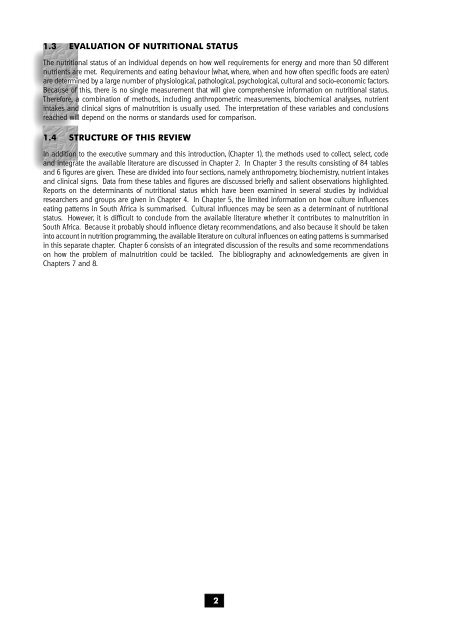the nutritional status of - Health Systems Trust
the nutritional status of - Health Systems Trust
the nutritional status of - Health Systems Trust
Create successful ePaper yourself
Turn your PDF publications into a flip-book with our unique Google optimized e-Paper software.
1.3 EVALUATION OF NUTRITIONAL STATUS<br />
The <strong>nutritional</strong> <strong>status</strong> <strong>of</strong> an individual depends on how well requirements for energy and more than 50 different<br />
nutrients are met. Requirements and eating behaviour (what, where, when and how <strong>of</strong>ten specific foods are eaten)<br />
are determined by a large number <strong>of</strong> physiological, pathological, psychological, cultural and socio-economic factors.<br />
Because <strong>of</strong> this, <strong>the</strong>re is no single measurement that will give comprehensive information on <strong>nutritional</strong> <strong>status</strong>.<br />
Therefore, a combination <strong>of</strong> methods, including anthropometric measurements, biochemical analyses, nutrient<br />
intakes and clinical signs <strong>of</strong> malnutrition is usually used. The interpretation <strong>of</strong> <strong>the</strong>se variables and conclusions<br />
reached will depend on <strong>the</strong> norms or standards used for comparison.<br />
1.4 STRUCTURE OF THIS REVIEW<br />
In addition to <strong>the</strong> executive summary and this introduction, (Chapter 1), <strong>the</strong> methods used to collect, select, code<br />
and integrate <strong>the</strong> available literature are discussed in Chapter 2. In Chapter 3 <strong>the</strong> results consisting <strong>of</strong> 84 tables<br />
and 6 figures are given. These are divided into four sections, namely anthropometry, biochemistry, nutrient intakes<br />
and clinical signs. Data from <strong>the</strong>se tables and figures are discussed briefly and salient observations highlighted.<br />
Reports on <strong>the</strong> determinants <strong>of</strong> <strong>nutritional</strong> <strong>status</strong> which have been examined in several studies by individual<br />
researchers and groups are given in Chapter 4. In Chapter 5, <strong>the</strong> limited information on how culture influences<br />
eating patterns in South Africa is summarised. Cultural influences may be seen as a determinant <strong>of</strong> <strong>nutritional</strong><br />
<strong>status</strong>. However, it is difficult to conclude from <strong>the</strong> available literature whe<strong>the</strong>r it contributes to malnutrition in<br />
South Africa. Because it probably should influence dietary recommendations, and also because it should be taken<br />
into account in nutrition programming, <strong>the</strong> available literature on cultural influences on eating patterns is summarised<br />
in this separate chapter. Chapter 6 consists <strong>of</strong> an integrated discussion <strong>of</strong> <strong>the</strong> results and some recommendations<br />
on how <strong>the</strong> problem <strong>of</strong> malnutrition could be tackled. The bibliography and acknowledgements are given in<br />
Chapters 7 and 8.<br />
2
















